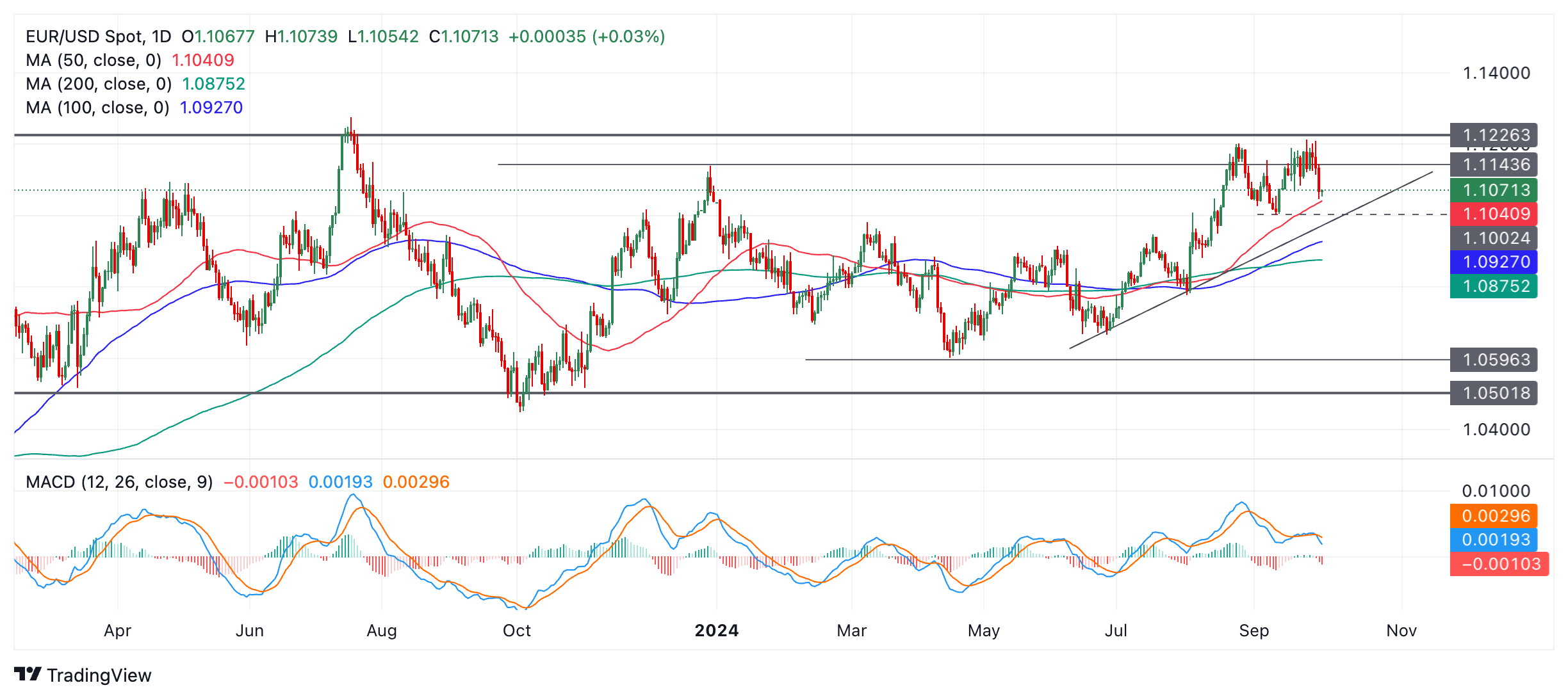- EUR/USD extends losses due to Euro weakness and increasing US Dollar strength.
- Euro depreciates due to lower inflation data; The Dollar benefits from solid employment data.
- An escalation of conflict in the Middle East has further increased safe haven flows into the USD.
EUR/USD is under pressure, trading at 1.1060 on Wednesday, after the pair fell from 1.1135 on Tuesday, in a sell-off that marked a 0.60% drop in one day.
Lower-than-expected Eurozone inflation data was partly responsible for the sharp drop. The bloc’s Harmonized Index of Consumer Prices (HICP) grew 1.8% year-on-year in September, below the previous 2.2% and expectations of 1.9%. Core inflation, for its part, stood at 2.7% year-on-year, one tenth below the 2.8% in August and also below expectations.
The data indicates that headline inflation has fallen below the European Central Bank’s (ECB) 2.0% target, and that core inflation is on track. This increases the chances that the ECB will cut interest rates further, which in turn will likely lead to capital outflows and a weaker Euro.
EUR/USD: Declines exacerbated by stronger USD
EUR/USD also came under downward pressure following a rally in the US Dollar (USD) on Tuesday.
The dollar gained ground following the release of data showing a larger-than-expected increase in the number of job openings in the US, according to JOLTS Job Openings, which rose to 8.04 million in August from 7.71. million revised upwards in July, and exceeded expectations of 7.66 million.
The data is significant given the Federal Reserve’s (Fed) recent shift toward concern about the labor market. This largely offset weaker US manufacturing activity data as measured by the ISM Manufacturing PMI, which remained in contraction territory and missed expectations in September.
EUR/USD also sold off amid escalating geopolitical tensions in the Middle East, increasing safe-haven flows into the US Dollar. On Tuesday night, Iran fired about 200 missiles, including some ballistic missiles, at Israel’s capital, Tel Aviv, in a retaliatory attack after Israel killed Hasan Nasrallah, the leader of the Iran-backed Hezbollah militant group.
More employment-related data on the horizon
The main releases likely to impact EUR/USD on Wednesday are the Eurozone Unemployment Rate for August; ADP US Employment Change data for September and comments from Federal Reserve (Fed) officials, including Fed Governor Michelle Bowman and Richmond Fed President Thomas Barkin.
Technical Analysis: EUR/USD possibly starting a decline within a multi-year range
EUR/USD has been contained within a wide multi-year range that has a top at around 1.1200 and a bottom around 1.0500. The pair is currently testing the top of the range, but after multiple touches it appears to be pulling back.
EUR/USD Daily Chart
EUR/USD is likely in a sideways trend on all its key time frames (short, medium and long term) and since it is a principle of technical analysis that “the trend is your friend”, the odds favor a continuation of this sideways trend, which in this case means a move back towards the lows of the range.
Prices now appear to be starting a bearish leg. They have reached a key support level in the form of the 50-day SMA at 1.1041, which is likely to slow the selling at least temporarily.
To confirm the start of a proper bearish leg, prices should break the 50-day SMA, the trend line of the last bullish leg, and the 9/11 low at 1.1002. A close below 1.1000 would therefore provide strong bearish confirmation. The downside target for such a move would be 1.0875, the 200-day SMA, followed by 1.0777 (Aug 1 low) and then 1.0600.
Momentum as measured by the Moving Average Convergence/Divergence Indicator (MACD) is relatively bearish in recent days and the blue MACD line has crossed below the red signal line, suggesting further evidence that the pair could be vulnerable to further weakness.
economic indicator
Consumer Price Index (YoY)
This indicator is published Eurostat and captures changes in the prices of goods and services. The consumer price index is an effective way to measure purchasing and inflation trends in the Eurozone. A better than expected result is bullish for the euro.
Last post:
Tue Oct 01, 2024 09:00 (Prel)
Frequency:
Monthly
Current:
1.8%
Dear:
1.9%
Previous:
2.2%
Fountain:
Eurostat
Why is it important for operators?
Source: Fx Street
I am Joshua Winder, a senior-level journalist and editor at World Stock Market. I specialize in covering news related to the stock market and economic trends. With more than 8 years of experience in this field, I have become an expert in financial reporting.








